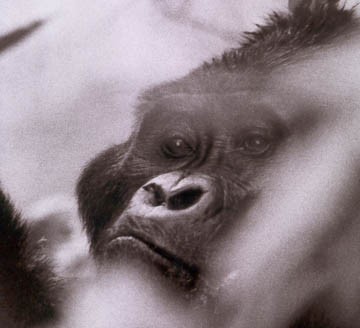Resource 4: Mountain Gorilla
![]() Example of pupils' work
Example of pupils' work
The Mountain Gorilla has longer and darker hair than other gorilla species, meaning it can live at high altitudes and travel into areas where temperatures drop below freezing.
Male gorillas usually weigh twice as much as female of the species. Adult males also have more pronounced bony crests on the top and back of their skulls, giving their heads a more conical shape. These crests anchor the massive muscles of their large jaws. Adult females also have these crests, but they are much less pronounced.

Nkuringo troop silverback, Bwindi, Uganda
Adult males are called silverbacks. When they reach sexual maturity, a saddle of gray or silver-colored hair develops on their backs. The hair on their backs is shorter than on most other body parts, and their arm hair is especially long. Upright, males reach 1.5–1.8 m in height, with an arm span of 2.25 m and weigh 204–227 kg.
Like all great apes other than humans, its arms are longer than its legs. It moves by knuckle-walking supporting its weight on the backs of its curved fingers rather than its palms.
The Mountain Gorilla is diurnal [Tip: hold Ctrl and click a link to open it in a new tab. (Hide tip)] , most active between 6:00 a.m. and 6:00 p.m. Many of these hours are spent eating, as large quantities of food are needed to sustain its massive bulk. It forages in early morning, rests during the late morning and around midday, and in the afternoon it forages again before resting at night. Each gorilla builds a nest from surrounding vegetation to sleep in, constructing a new one every evening. Only infants sleep in the same nest as their mothers. They leave their sleeping sites when the sun rises at around 6 am, except when it is cold and overcast; then they often stay longer in their nests.
Useful organisations to contact:
Uganda Wildlife Education Centre, Entebbe (http://www.ugandawildlifecentre.com)
Uganda Wildlife Authority (http://www.uwa.or.ug)
Adapted from: Wikipedia, Website
Resource 3: History of technology



